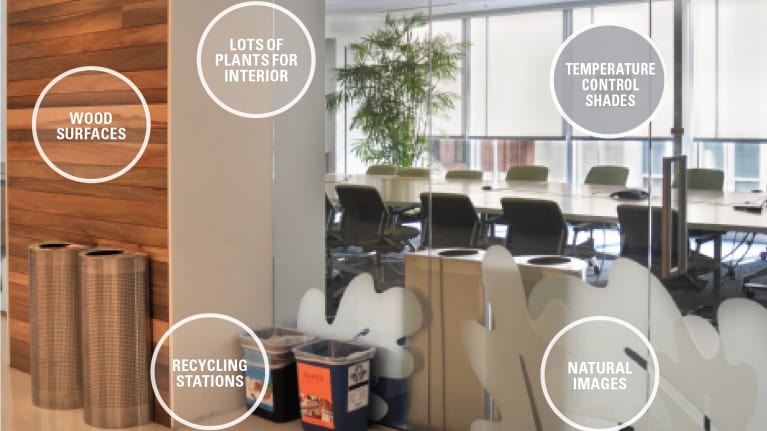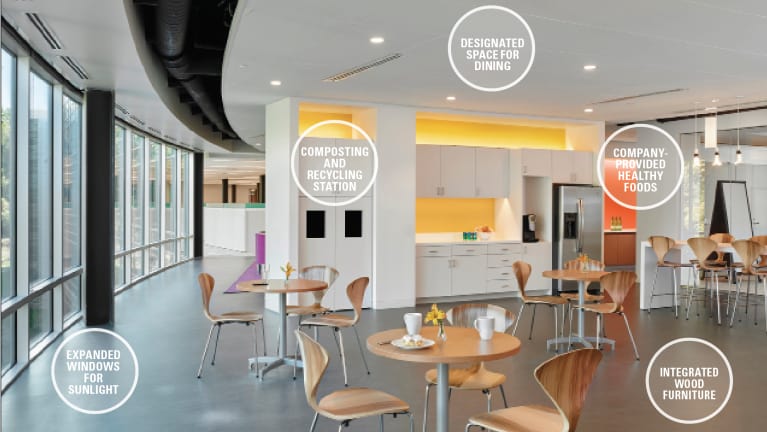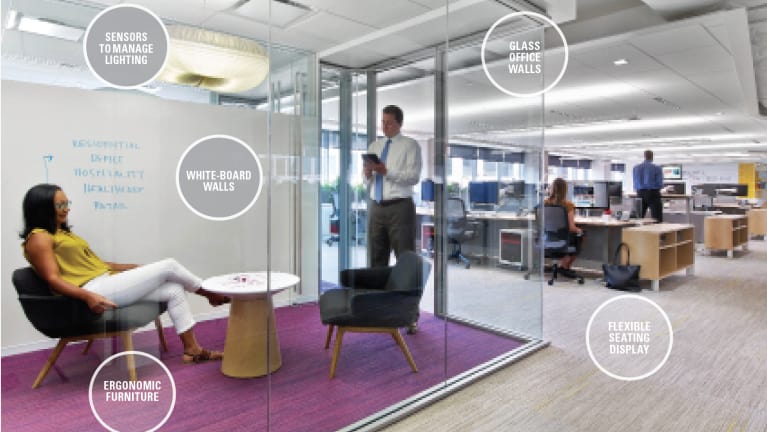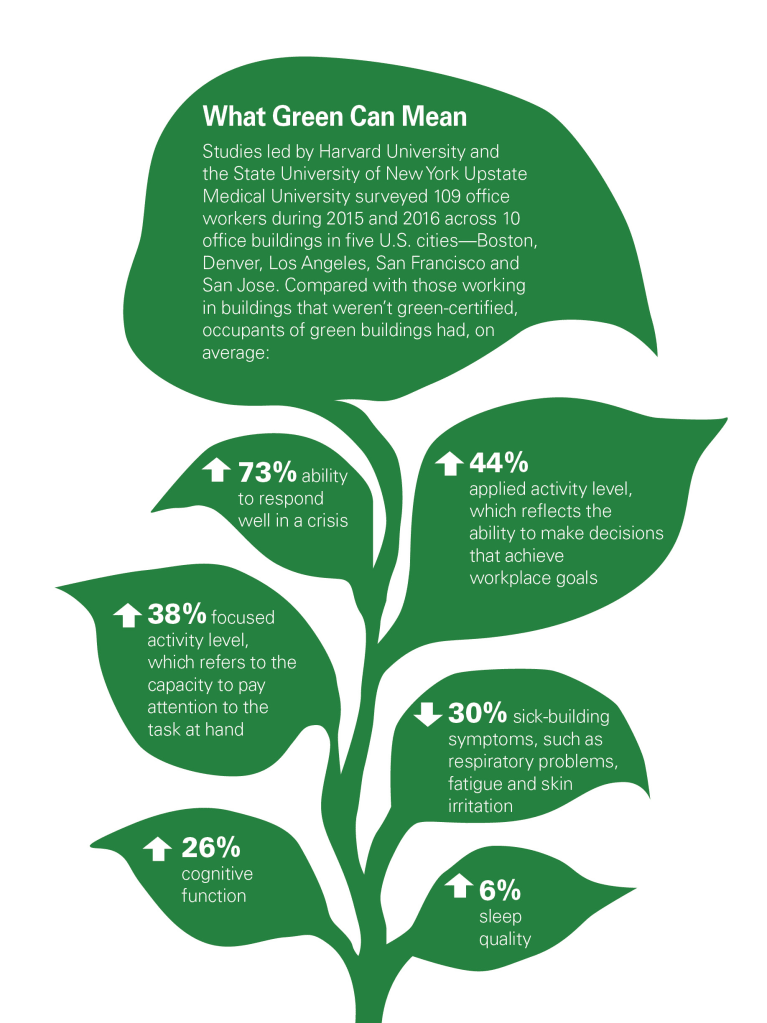Why Green Building Matters for HR
Sustainable design practices lead to happy employees—and healthy businesses. Here's how HR can take the LEED.
Introduction
Of all the tasks that HR tackles—hiring, training, payroll and managing employee relations, to name a few—workplace design isn’t usually one that comes to mind. Increasingly, however, there’s a case to be made that it deserves a place on the list. For example, when the Unitarian Universalist Association (UUA) decided to move from multiple buildings in the Beacon Hill area of Boston to the city’s Seaport District, the effort was spearheaded by the director of human resources, Rob Molla (pictured above, left, facing).
“HR led the design team on this project because it’s about how people work,” Molla says. “It was about changing our culture.” He knew that, depending on how UUA used its new space, the design could break down silos, improve communication and bolster employee flexibility. So, in addition to keeping up with the latest talent management trends, he began studying workstation and universal design, ergonomics, acoustics, and lighting.
UUA had been located on Beacon Hill for about 200 years, but it had long outgrown its space. Employees were spread over four buildings on about 16 floors. “It was difficult to communicate,” Molla says. “You could go weeks, sometimes months, without seeing some of your co-workers.” In 2014, the organization moved into a renovated 1895 wool warehouse in the burgeoning Fort Point Channel area. UUA’s 210 employees occupy three floors, and the organization leases out the other three.
Every aspect of the space took into account UUA’s guiding principles as well as the doctrine of LEED—Leadership in Energy and Environmental Design. Created by the U.S. Green Building Council (USGBC), LEED is a rating system that evaluates and encourages sustainable design, construction and maintenance. In a study of federal government buildings, those that were LEED-certified had 34 percent lower carbon dioxide emissions and consumed 25 percent less energy and 11 percent less water.
But even more relevant for HR: A 2016 Harvard study found that employees in green-certified buildings scored 26 percent higher on cognitive function tests (controlling for annual earnings, job category and level of schooling) and had 30 percent fewer sick-building symptoms than those in noncertified buildings.

UUA’s design and construction choices for its new location led to a platinum certification—LEED’s highest designation. Some of the innovations include carpeting and paint with zero toxic emissions, a glass-enclosed lift in the building entrance (which enables those who can’t take stairs to enter with their colleagues without feeling hidden away), and gender-neutral restrooms that accompany gender-specific ones on each floor. UUA reused 30 percent of its furniture from its old space, and 38 percent of the new materials were purchased from regional suppliers. The building uses 40 percent less energy and 35 percent less water than its previous headquarters.
“We knew that no one workstation design would work for every person,” says Molla, who brought in a design expert to develop the individual workstations. “Going back to [UUA’s] first principle—which values the inherent worth and dignity of every person—we chose components and we allowed every person to individualize.”
HR professionals such as Molla are standing side by side with CEOs as they plan construction and renovation projects based on the LEED principles. Companies can seek different levels of certification—certified, silver, gold and platinum—earning points as they address sustainability issues in several areas. And LEED certification is not only for new construction or renovation. Buildings can seek the credential based on changes in operations and maintenance as well.
Moreover, even businesses that aren’t seeking LEED certification can follow the principles to improve their workplaces and cultures. Indeed, there’s a shade of green to fit every company size and budget. Being more sustainable can mean anything from offering employees fresh fruits and veggies in the cafeteria to replacing harsh cleaning products to rethinking space to optimize people’s access to quality views.
“Even if they’re not looking to retrofit their building or get a new building, HR can be involved in working with facilities on space planning or office design to encourage collaboration, to help boost employee engagement by figuring out how to maximize daylighting,” says Ashley Fowler, USGBC manager, talent management.
[Members' Only Toolkit: Introduction to the Human Resources Discipline of Ethics and Corporate Social Responsibility and Sustainability]
Saint-Gobain: Showcasing Light and Life
When building materials company Saint-Gobain began making plans to build a new headquarters in Malvern, Pa., Senior Vice President of Human Resources Valerie Gervais had several goals in mind, including to increase collaboration and create an environment that would best attract and retain talent.
“We started to think about all kinds of creative ways of offering things to people,” Gervais says. “What is it they want?” Nowadays there is a blurring of boundaries between people’s work and personal lives, so employees expect more from their place of employment. “It’s actually providing an environment where I can improve myself, I can improve my health, and that’s what we’re trying to do,” Gervais says.
The 320,000-square-foot headquarters opened for its more than 800 employees on Oct. 15, 2015—the company’s 350th anniversary. Saint-Gobain was founded when King Louis XIV sought help to make his vision for the Hall of Mirrors at the Palace of Versailles in Paris a reality. The company, which is double-platinum LEED-certified, has systems that purify and monitor the indoor air quality and continuously collects data on humidity, air velocity and volatile organic compounds, or VOCs, which are chemicals emitted as gasses from products that may have adverse health effects.
[Members' Only Q&A: Sustainability—What is corporate sustainability, and how can HR help make a business case for it?]
The building is filled with natural light—which not only saves on energy costs but also helps employees thrive. The windows are made from electrochromic glass, which uses sensors to monitor sunlight and automatically tints windows throughout the day as needed, eliminating the need for blinds. Research indicates that access to daylight improves people’s cognitive functioning, stress levels and sleep patterns, says Kelly Worden, USGBC project manager, health research. A 2014 study showed that workers in windowless environments engaged in less physical activity and had poorer sleep than those exposed to daylight at work.
Ninety-two percent of Saint-Gobain’s spaces have access to natural light and views of the outdoors. This follows a concept called biophilic design, which recognizes that giving people a connection to nature helps them to be healthy and productive. Outdoors, Saint-Gobain has a community garden, grass to play sports on, a bocce court and walking trails around a pond.
Steps to Sustainability | |||
|---|---|---|---|
Workplace Dimension | Small Steps | Middle-of-the-Road Approach | Larger Investment |
Food | • Provide reusable cutlery and dishes sized for healthy portions. • Devote indoor and outdoor space to dining. • Encourage people to dine with colleagues. | • Find local healthy caterers. • Provide shared foods, including a top coffee station, herb gardens inside and communal gardens outside. | • Provide composting and healthy meals. • Retain a kitchen staffer to encourage and maintain green efforts, cleanliness and waste management efficiency. |
| Office Design | • Add lots of plants to interior and exterior environments. • Use natural images in art and photos. • Integrate sustainable, reclaimed furniture. | • Adopt flexible seating arrangements. • Incorporate flexible furniture (pods that enable easier meetings), glass-walled offices and meeting rooms. • Embed mics/cameras in meeting rooms for remote workers. | • Expand office windows to bring light throughout the workplace. • Add shading and temperature controls based on sunlight. • Offer outdoor or rooftop meeting space. |
Fitness | • Offer powered exercise equipment. • Provide or promote use of fitness trackers. • Give smoking-cessation, weight-control and other health-conscious classes. | • Purchase ergonomic furniture. • Offer the option of standing or treadmill desks, cycling desks, ball seats, etc. • Encourage biking to work with covered racks and storage. | • Provide an onsite fitness center with a workout advisor. • Offer onsite yoga and cardio programs. • Give subsidies for outside fitness or exercise programs. • Create an outdoor walking path. |
| Maintenance & Facilities Management | • Use and provide green cleaning supplies. • Set up paper, plastic and office supply recycling stations with posters educating employees on correct recycling procedures. | • Provide advanced waste management onsite. • Integrate sensors to manage lighting, heating and cooling, depending on who is at work. • Upgrade plumbing in restrooms and kitchens to low-flow water. | • Revise hours so that cleaning staff work during the day and become part of the team, which also ensures that energy isn’t wasted after hours by lighting mostly empty buildings. |
USGBC: Achieving the Three P’s
Of course, few would argue that creating a more pleasing workspace for employees isn’t a noble goal. But HR professionals understand, often better than anyone, that if their efforts don’t make financial sense for the company, they won’t get approval from the top.
The key to success is striving to deliver on the triple bottom line of people, planet and profit, says Melanie Mayo-Rodgers, USGBC manager, facilities. For people, this can mean boosting well-being by encouraging employees to easily walk or bike to stores and services or to take public transit to work, for example. For the planet, it may be reducing greenhouse gas emissions and using native plants for landscaping. For profit, it could involve helping companies attract and retain employees who want a healthy, sustainable, ergonomically designed workplace, while also reducing many office and health care costs.
It’s no surprise that USGBC, which has 262 employees, has earned its own platinum LEED certification for its headquarters, a leased space in Washington, D.C. In addition to maximizing daylight and air quality—which is particularly important for those with allergies and compromised immune systems—the organization’s design plan uses energy efficiently and leverages sustainable construction and cleaning products.
USGBC monitors its LEED performance, showcasing the results on a digital display in its main lobby. The system collects data and establishes a score based on strategies in five areas: energy, water, waste, transportation and human experience.
Meters measure the quality of the air and water and how much energy USGBC is using, and employees track waste and recycling. HR uses employee surveys to capture data on how people commute and experience their workspace.
As you walk off the elevator and through the glass doors into the USGBC lobby, you’ll notice an open, airy staircase leading to the sixth floor—a welcome alternative to the closed-off stairs on the edge of the building. In the lobby, a wood backdrop features a waterfall and live plants grow in pots next to the stairs.
Along the lobby are several conference rooms with glass doors that have images of oak leaves etched into them. The largest is the boardroom, which allows for different setups of round or rectangular tables. Stackable chairs are stored in a small space in the adjoining storage room. To minimize noise, the room’s ceiling tiles are slanted and the walls are slightly angled and fabric-covered.

The building envelope—the physical separator between the indoors and outdoors—conserves energy in three ways: double-pane glass, shades that automatically raise and lower throughout the day based on a sensor, and a pass wall of air that creates an invisible barrier between outside and inside temperatures.
Head into the employee work areas, and you’ll see that there are no cubicles abutting the windows—which means more people get access to direct light. This design also decreases energy needs, since workstations situated right against windows require more heating and cooling. The ergonomic workstations have LED task lighting—although many employees rely on the natural light enveloping the space—and Herman Miller chairs provide lumbar support and adjustable heights and arms.
Multicolored glass dividers indicate you’re entering the less formal areas of the game room and kitchen. Whimsical, colorful seating is all around, and since employees use laptops, they can choose to work from whatever space they’re inspired by. The glistening white kitchen is divided into three areas: food storage and prep, eating, and cleanup. Explanatory photos show the best way to sort refuse into the recycling, trash and compost bins. And herb plants line the window, allowing employees to cut and add the edibles to their daily meals.
The American Society of Interior Designers: A Natural Fit
When the American Society of Interior Designers (ASID) built out its new 8,500-square-foot office in Washington, D.C., in 2016, it was a natural fit to encompass LEED principles. After all, ASID’s mission includes the idea that interior design can enhance people’s lives. ASID also sought the WELL Building Standard awarded by the International WELL Building Institute to advance health and well-being in buildings. In fact, this year ASID’s headquarters became the first space in the world to achieve platinum-level certification for both the WELL Building Standard and LEED.
The goal at ASID was to design the new space so that “it speaks to the future of workplace design and how workplaces are designed to increase productivity, to make sure employees are effective, to make sure they’re functional, and [so that it takes] into consideration the general health and well-being of those who work in the space,” says Katina Davis, ASID HR director.
ASID sold its Capitol Hill building and worked out of a WeWork co-working space for about a year while it scouted buildings and built out its new headquarters. WELL standards revolve around seven components: air, water, nourishment, light, fitness, comfort and mind. Embracing these concepts, ASID provides fresh fruit and vegetables to employees, and it requires that catered events have vegan, gluten-free and dairy-free options.
ASID’s kitchen, which is called the “café,” stores dishes sized to encourage healthy portion sizes, and each employee is issued a water bottle and a Fitbit. ASID’s building has a fitness center—a requirement when the team was searching for a new headquarters—and employees are permitted to work out during the day if they prefer that over exercising before or after work.
The organization, which has 35 employees, covers the full cost of health insurance for employees and their dependents and recently increased paid maternity/paternity leave to eight weeks from four. A wellness/lactation room includes a refrigerator, comfortable seating, dimmer lighting, yoga mats and essential oils. The room is engineered to be quieter than a typical office, and if it isn’t being used by breast-feeding moms, employees can use it to relax, meditate, do yoga, stretch or even take a nap.
“People feel good about working here because they feel that we care about them,” Davis says, “and it’s also been an excellent recruiting tool when I share with people some of the benefits that we offer in the office.”

When job candidates come in for interviews, they’re often pleased—and sometimes surprised—at the bright, airy, open space, Davis says. ASID has 28 workstations, which all have motorized sit-stand desks that allow employees to switch between the two options in about six seconds.
A study supported by ASID’s foundation revealed that employees who used standing desks reported improved productivity and health. The yearlong study at Perkins+Will’s Atlanta office found that people who used adjustable workstations experienced a 65 percent improvement in productivity compared to those who kept traditional desks. Moreover, 65 percent said the adjustable setup positively affected their health outside of work.
ASID also has four private offices that are not assigned to any one person but are available for staff to reserve as needed for a few hours or a few days. The CEO has a workstation alongside everyone else—and he has reserved the private office only once. The space that the architects had originally intended to be his corner office became a cool lounge area with comfy, inviting seats that all can use.
Start Small
While these organizations invested significantly to meet high standards, HR professionals can embrace some of the same concepts at minimal cost by taking baby steps to become more green and improve workplace culture as well as employee productivity, health and well-being.
“There’s always a starting point,” Davis says. “As an HR professional, [I found that] undertaking this project really opened my eyes to a lot of things that can be beneficial to employees that may not necessarily always have a dollar value associated with it but they make a huge difference,” Davis says.
Melanie Padgett Powers is a freelance writer and editor in the Washington, D.C., area.
Was this article useful? SHRM offers thousands of tools, templates and other exclusive member benefits, including compliance updates, sample policies, HR expert advice, education discounts, a growing online member community and much more. Join/Renew Now and let SHRM help you work smarter.



